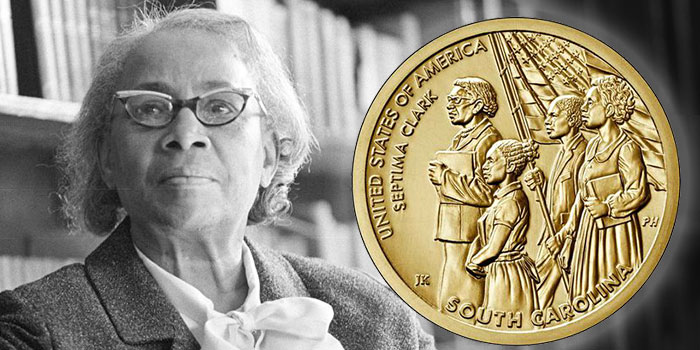
By Chris Bulfinch for CoinWeek …..
South Carolina’s American Innovation Dollar honors Septima Poinsette Clark, a teacher and civil rights activist whose decades of work educating voters was an inspiration to other leaders of the Civil Rights Movement. Proof Sets including the coin went on sale on October 8 of last year. Business strikes and Reverse Proof examples South Carolina’s American Innovation dollar coin will be made available to collectors later this month and at the beginning of February, respectively.
The Life of Septima Clark
Septima Clark was born May 3, 1898, in Charleston, South Carolina. Her father, who was a formerly enslaved person, and her mother, who was born in Haiti, taught Clark to read and write early in her life. After graduating from secondary school in 1916, Clark began teaching at a Black school on Johns Island, just off the coast. She taught in both Charleston and Columbia, though the segregated school system barred her from teaching in Charleston’s public school system.
Clark joined the NAACP, working on a 1919 campaign to overturn Charleston’s ordinance against Black teachers, and during World War II she joined a successful NAACP lawsuit for pay equity for Black teachers in South Carolina. She studied under civil rights activist W.E.B. Du Bois, earning her bachelor’s and master’s degrees in the 1940s.
Charleston’s school board fired her for her membership in the NAACP in 1956 after the state barred city and state employees from belonging to civil rights organizations. She became director of workshops at the Highlander Folk School in Monteagle, Tennessee, creating “Citizenship Schools” that taught “literacy, their rights and duties as U.S. citizens, and how to fill out voter registration forms,” according to Stanford’s Martin Luther King, Jr. Research and Education Institute.
The Southern Christian Leadership Conference (SCLC) started creating “Freedom Schools” in 1961 based on Clark’s workshops; Clark became their director of education and teaching at the same time after the state of Tennessee closed the Highlander Folk School.
Clark continued working in the SCLC until retiring in 1970, though she continued leading workshops after she retired. She was elected to Charleston’s school board and her teacher’s pension was reinstated in the ’70s, and in 1982 she was awarded the Order of the Palmetto, South Carolina’s highest civilian award. She received the Race Relations Award from the National Education Association (NEA) and was awarded an honorary doctorate of humane letters from the College of Charleston.
Clark continued her work as an educator and activist until her death on December 15, 1987.
The Coin
American Innovation designs are the result of a process that begins with the United States Mint and the Governor/chief executive of each state/territory. The Mint contacts the office of each state’s chief executive to request the appointment of a liaison, who develops a list of one to three subjects “emblematic of innovation significant and meaningful to their jurisdiction and/or its role in the nation.”
With a group of subjects, the Mint solicits designs from its staff, reviews the results, and presents selections to the state’s liaison, who offers feedback. After any necessary modifications, the final group of designs is presented to the liaison, the Citizens’ Coinage Advisory Committee (CCAC), and the Commission of Fine Arts (CFA), who offer recommendations.
According to the CCAC’s 2019 report, Clark was not the only subject considered for South Carolina’s American Innovation dollar. The CCAC chose designs honoring Clark over the MASER (Microwave Amplification by Stimulated Emission of Radiation), an invention of South Carolina native Charles H. Townes and a team of other scientists.
South Carolina’s governor, Henry McMaster, favored the same theme and design as the CCAC, according to Paul Gilkes’ reporting in Coin World. Clark leads a group of children carrying books and an American flag, with her name and “UNITED STATES OF AMERICA” at right, flanked by the initials of the artists responsible for the design.
Artistic Infusion Program (AIP) artist Justin Kunz designed the coin, and Phebe Hemphill, a member of the Mint’s team of medallic artists, sculpted it. Kunz also designed the American Innovation dollars’ common obverse, depicting the Statue of Liberty.
Another proposed design featured Clark teaching, book in hand, in front of a chalkboard rendered as the Constitution. The CFA recommended that design, which the CCAC described as “a close second recommendation.”
77,802 of the American Innovation Proof Sets have sold as of January 3, 2021, according to the Mint’s sales figures. Business strikes were produced at the Philadelphia and Denver Mints, while Proof and Reverse Proof pieces were struck in San Francisco. Despite their release in 2021, all coins were struck in 2020, according to Michael White, a Mint spokesperson.
Rolls and bags of the coins from the Philadelphia and Denver Mints will be made available on Jan. 19 of this year. Reverse Proof coins will be available on February 1. 25-coin roles are priced at $34.95, while 100-coin bags are priced at $117.50; pricing information is not available for the Reverse Proof coin.
Other 2020 Reverse Proof American Innovation dollars were sold for $11.50 last year.
Related Civil Rights Mint Products
Septima Clark’s activism joins a number of other themes related to the Civil Rights Movement commemorated by the U.S. Mint over the last 15 years, including the 2014 Civil Rights Act Commemorative silver dollar, the 2015 Congressional Gold Medal honoring the Selma to Montgomery Marches, and the 2007 Little Rock Central High School Desegregation silver dollar.
Commemorative coins celebrating the accomplishments of Black Americans were issued in the 1940s, ’50s, and ’90s. These include the Booker T. Washington half dollar (1946-1951), the George Washington Carver half dollar (1951-1954), the 1997 Jackie Robinson silver dollar, and the 1998 Black Revolutionary War Patriots silver dollar, which features Crispus Attucks on the obverse.
Sources
www.usmint.gov/learn/coin-and-medal-programs/american-innovation-dollar-coins
www.ccac.gov/media/aboutUs/annualReports/CCAC_2019_Annual_Report.pdf
Coin World, Oct. 2019 monthly, pg. 43
www.ccac.gov/media/aboutUs/annualReports/CCAC_2019_Annual_Report.pdf
Coin World, Dec. 2019 monthly, pg. 34
www.usmint.gov/about/production-sales-figures/cumulative-sales




